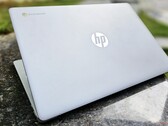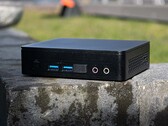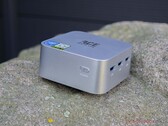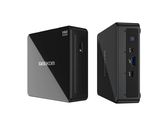
MediaTek beats Intel - Asus Chromebook CX14 review
Intel Celeron N4500 | Intel UHD Graphics (Jasper Lake 16 EU) | 14.00" | 1.4 kg

The Intel UHD Graphics 16 EUs (Jasper Lake, Gen. 11) is an integrated graphics card in the Jasper Lake Celeron SoCs for laptops and small desktops. It is the low end GPU version in the Jasper Lake series (Celeron Dual-Cores) and offers only 16 of the 32 EUs (Execution Units / Shader Blocks). It offers no dedicated graphics memory and the clock rate depends on the processor model. At launch there are two Celeron models (N4500 with 6W and N4505 with 10W) clocked at 350 - 750 MHz.
Thanks to the improved architecture and more EUs, the UHD Graphics is clearly faster than the old Gemini Lake SoCs (e.g. UHD Graphics 600).
A special new feature of the Gen11 graphics card is the new Variable Rate Shading (VRS) support. With it game designers can decide where to spend shading time and e.g. shade object in the background or behind fog with less resolution (up to using only one source for a 4x4 block). With this technique early results show up to 1.3x performance in Unreal Engine POC and 1.2x speedup in Civ 6. Up to now VRS is only supported by the new Nvidia Turing architecture (GTX 1650 and up).
Another improved hardware piece is the integrated video de- and encoder that was improved significantly according to Intel. They did not specify any more details, but the previous generation was able to decode VP9 and H.265/HEVC in Main10 profile with 10 bit color depth using the dedicated hardware.
The Jasper Lake SoCs and therefore the integrated GPU are manufactured in the 10nm process (like Ice Lake probably) at Intel that should be comparable to the 7nm process of TSMC.
Gen. 11 Series
| |||||||||||||||||||||||||||||||
| Codename | Gen. 11 | ||||||||||||||||||||||||||||||
| Architecture | Gen. 11 | ||||||||||||||||||||||||||||||
| Pipelines | 24 - unified | ||||||||||||||||||||||||||||||
| Core Speed | 350 - 800 (Boost) MHz | ||||||||||||||||||||||||||||||
| Shared Memory | yes | ||||||||||||||||||||||||||||||
| API | DirectX 12_1, OpenGL 4.5, OpenCL 1.2 | ||||||||||||||||||||||||||||||
| Power Consumption | 4.8 - 10 Watt | ||||||||||||||||||||||||||||||
| technology | 10 nm | ||||||||||||||||||||||||||||||
| Displays | 3 Displays (max.) | ||||||||||||||||||||||||||||||
| Features | QuickSync | ||||||||||||||||||||||||||||||
| Date of Announcement | 11.01.2021 | ||||||||||||||||||||||||||||||
| Predecessor | UHD Graphics 600 | ||||||||||||||||||||||||||||||
| ||||||||||||||||||||||||
The following benchmarks stem from our benchmarks of review laptops. The performance depends on the used graphics memory, clock rate, processor, system settings, drivers, and operating systems. So the results don't have to be representative for all laptops with this GPU. For detailed information on the benchmark results, click on the fps number.









| low | med. | high | ultra | QHD | 4K | |
|---|---|---|---|---|---|---|
| F1 25 | ||||||
| F1 22 | ||||||
| Elden Ring | 5.18 | |||||
| F1 2021 | 19 | |||||
| Total War: Three Kingdoms | 15.2 | |||||
| Shadow of the Tomb Raider | 7 | |||||
| Strange Brigade | 16 | 7 | 6 | |||
| Far Cry 5 | 7 | |||||
| X-Plane 11.11 | 12 | 9 | 8 | |||
| Final Fantasy XV Benchmark | 6 | 3 | 2 | |||
| Dota 2 Reborn | 48 | 24 | 12 | 11 | ||
| The Witcher 3 | 11 | |||||
| GTA V | 13 | 25 | 5.59 | |||
| Counter-Strike: GO | 57.6 | 48.1 | 17.8 | |||
| low | med. | high | ultra | QHD | 4K | < 30 fps < 60 fps < 120 fps ≥ 120 fps | 10 2 | 5 1 | 5 | 2 | | |
For more games that might be playable and a list of all games and graphics cards visit our Gaming List





Beelink U59 Mini-S: Intel Celeron N5095, 0.3 kg
Review » Beelink U59 Mini-S mini PC review: The super inexpensive Intel NUC HTPC alternative
Beelink U59: Intel Celeron N5095, 0.3 kg
Review » Intel Celeron N5095 Jasper Lake benchmarked: Beelink U59 mini PC review
Asus BR1100FKA-BP0109RA: Intel Celeron N4500, 11.60", 1.4 kg
Review » Asus BR1100FKA in review: Affordable and shockproof convertible
Asus Chromebook CX15 CX1505CKA: Intel Celeron N4500, 15.60", 1.6 kg
External Review » Asus Chromebook CX15 CX1505CKA
Asus Chromebook CX1400: Intel Celeron N4500, 14.00", 1.2 kg
External Review » Asus Chromebook CX1400
Acer Aspire 1 A115-32-C96U: Intel Celeron N4500, 15.60", 1.8 kg
External Review » Acer Aspire 1 A115-32-C96U
HP Chromebook 15a-na0012TU: Intel Celeron N4500, 15.60", 1.7 kg
External Review » HP Chromebook 15a-na0012TU
Asus Vivobook Go 14 Flip TP1400KA-EC040WS: Intel Celeron N4500, 14.00", 1.5 kg
External Review » Asus Vivobook Go 14 Flip TP1400KA-EC040WS
HP Chromebook 14a-na1012ns: Intel Celeron N4500, 14.00", 1.5 kg
External Review » HP Chromebook 14a-na1012ns
Acer Aspire 3 A315-35-C8XU: Intel Celeron N4500, 15.60", 2.2 kg
External Review » Acer Aspire 3 A315-35-C8XU
Samsung Galaxy Chromebook2 360: Intel Celeron N4500, 12.40", 1.3 kg
External Review » Samsung Galaxy Chromebook2 360
Asus Vivobook Go 14X E410MA-EB1272WS: Intel Celeron N4500, 14.00", 1.3 kg
External Review » Asus Vivobook Go 14X E410MA-EB1272WS
Asus Chromebook Flip CR1 CR1100FKA-BP0023: Intel Celeron N4500, 11.60", 1.4 kg
External Review » Asus Chromebook Flip CR1 CR1100FKA-BP0023
Lenovo Flex 3i Chromebook 11-82N30012HA: Intel Celeron N4500, 11.60", 1.2 kg
External Review » Lenovo Flex 3i Chromebook 11-82N30012HA
Acer Swift 1 SF114-34-C1CG: Intel Celeron N4500, 14.00", 1.3 kg
External Review » Acer Swift 1 SF114-34-C1CG
Acer Aspire 1 A114-33-C51G: Intel Celeron N4500, 14.00", 1.5 kg
External Review » Acer Aspire 1 A114-33-C51G
Asus BR1100CKA-GJ0303RA: Intel Celeron N4500, 11.60", 1.2 kg
External Review » Asus BR1100CKA-GJ0303RA
Samsung Galaxy Chromebook Go 14 XE340XDA-KA1US: Intel Celeron N4500, 14.00", 1.5 kg
External Review » Samsung Galaxy Chromebook Go 14 XE340XDA-KA1US
CTL Chromebook NL72: Intel Celeron N4500, 11.60", 1.3 kg
External Review » CTL Chromebook NL72
Chuwi Hi10 Go: Intel Celeron N4500, 10.10", 0.7 kg
External Review » Chuwi Hi10 Go
Acer Chromebook 317 CB317-1H-C994: Intel Celeron N4500, 17.30", 2.4 kg
External Review » Acer Chromebook 317 CB317-1H-C994
Asus BR1100FKA-BP0109RA: Intel Celeron N4500, 11.60", 1.4 kg
External Review » Asus BR1100FKA-BP0109RA
» Asus BR1100FKA: Robust, but with limited application scenarios
» Comparison of GPUs
Detailed list of all laptop GPUs sorted by class and performance.
» Benchmark List
Sort and restrict laptop GPUs based on performance in synthetic benchmarks.
» Notebook Gaming List
Playable games for each graphics card and their average FPS results.
Top 10 Laptops
Multimedia, Budget Multimedia, Gaming, Budget Gaming, Lightweight Gaming, Business, Budget Office, Workstation, Subnotebooks, Ultrabooks, Chromebooks
under 300 USD/Euros, under 500 USD/Euros, 1,000 USD/Euros, for University Students, Best Displays
Top 10 Smartphones
Smartphones, Phablets, ≤6-inch, Camera Smartphones